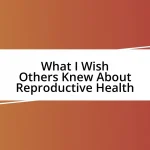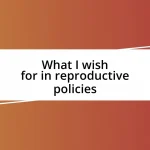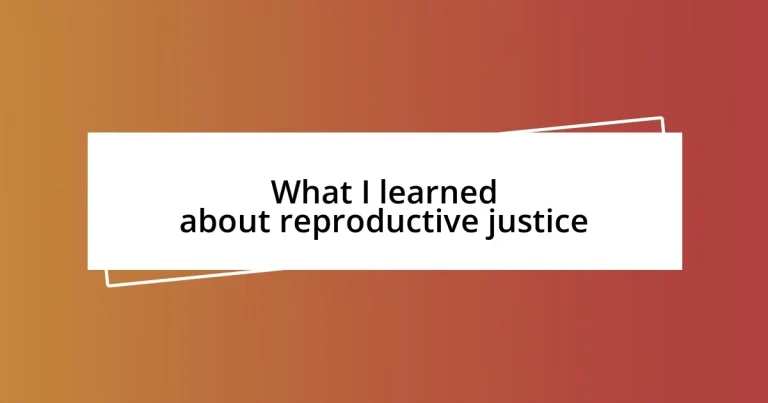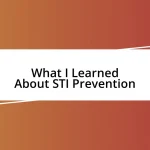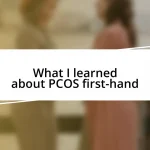Key takeaways:
- Reproductive justice encompasses economic, social, and political dimensions, and emphasizes the importance of creating an equitable environment for all individuals to access reproductive health care.
- Historical context is crucial; the struggles for reproductive rights are tied to broader civil rights movements, particularly those led by marginalized communities, highlighting the need for holistic change in society.
- Intersectionality is fundamental in reproductive justice, as it acknowledges how race, class, and gender identity shape individual experiences and access to care, necessitating community activism and collaboration for effective advocacy.
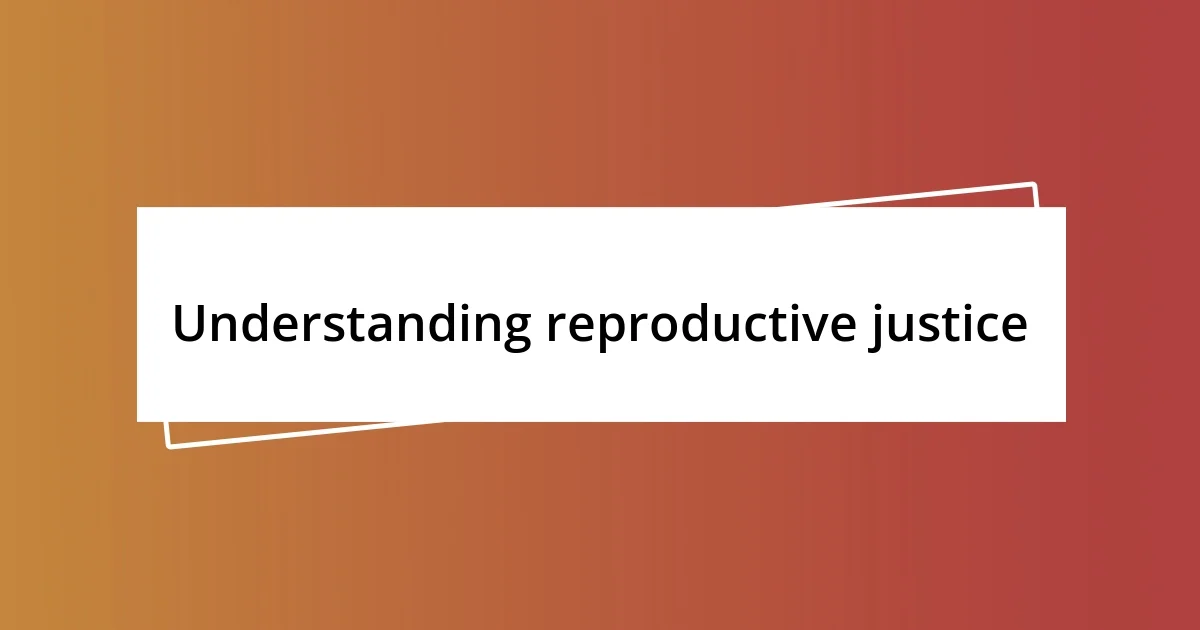
Understanding reproductive justice
Understanding reproductive justice involves acknowledging that reproductive rights go beyond the mere ability to access contraception or abortion. For me, it’s a multifaceted issue that encompasses economic, social, and political dimensions. Isn’t it interesting how much access and agency can vary based on where you live or your socio-economic status?
One experience that stands out to me was attending a community workshop on reproductive health. Hearing stories from women facing barriers – from transportation to clinics to lack of culturally competent care – truly opened my eyes. It made me realize that reproductive justice isn’t just about individual choices; it’s about creating an environment where everyone can thrive and exercise their rights without obstacles.
Moreover, I find it essential to consider the intersectionality within reproductive justice. How do race, class, and gender identity intertwine in shaping one’s reproductive choices? From my perspective, the need for a holistic approach is clear. Each person’s story sheds light on the systemic inequalities that persist, reminding me that reproductive justice must advocate for the marginalized voices who often go unheard.
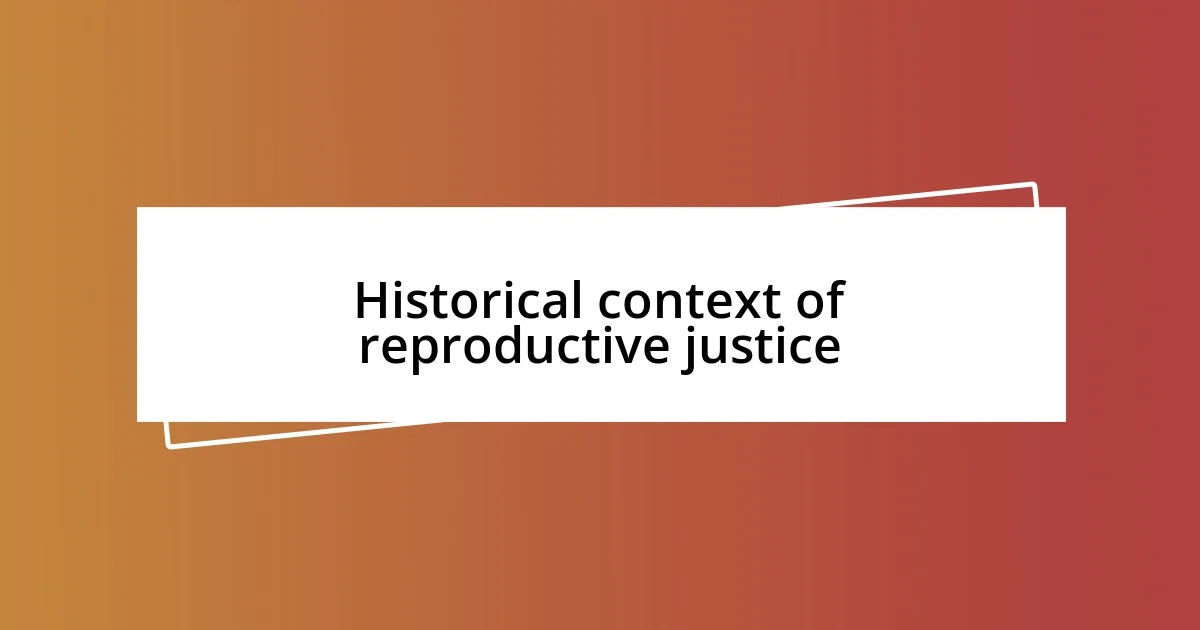
Historical context of reproductive justice
Reproductive justice has deep roots in the struggles for civil rights and social justice. Historically, marginalized communities, particularly women of color, have fought for their reproductive rights within broader movements for equality and justice. I remember reading about the Combahee River Collective, whose members highlighted the importance of addressing both race and gender, illustrating that reproductive justice must include the fight against systemic oppression. Their work taught me that accessing reproductive health care is intricately tied to achieving freedom in every aspect of life.
The concept of reproductive justice gained prominence in the 1990s when activists began linking social justice with reproductive rights. I often reflect on how the activism of figures like Loretta Ross and others brought attention to the idea that reproductive choices must be embraced alongside social and economic equality. Learning about their grassroots efforts made me realize that reproductive justice isn’t solely about policies; it encompasses the lived experiences of individuals facing inequalities. Each story conveys a powerful testament to the need for holistic change in society.
When examining reproductive justice today, it’s crucial to recognize the impact of historical oppression on current policies and practices. For instance, the legacy of forced sterilizations, especially among marginalized women, serves as a stark reminder of the ongoing struggles within reproductive health. My heart aches when I think about how these injustices have shaped the perspectives of many who now fight for their right to make informed choices about their bodies and lives. Understanding this historical context is essential; it empowers us to advocate for comprehensive reproductive justice today.
| Time Period | Key Events |
|---|---|
| 19th Century | Focus on women’s rights, early advocacy for contraception |
| 1960s-70s | Legalization of abortion, rise of feminist movements |
| 1990s | Coalescence of reproductive rights with social justice activism |
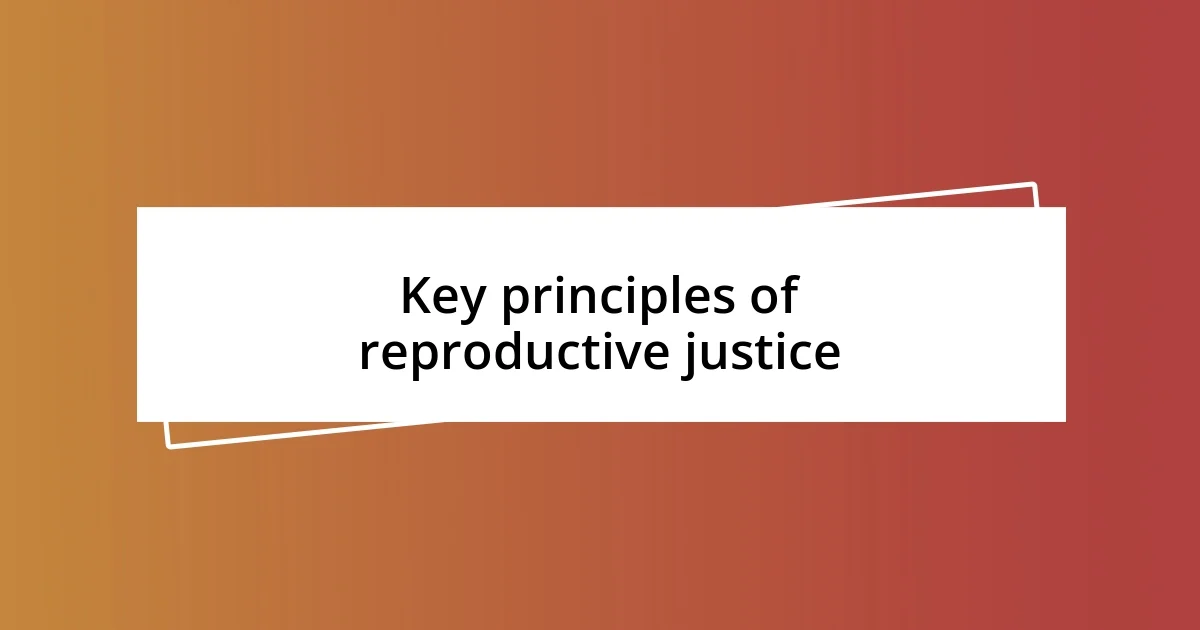
Key principles of reproductive justice
Reproductive justice is founded on several key principles that guide its advocacy and activism. Personally, I’ve come to see these principles as essential, not just as abstract concepts, but as frameworks that reflect the real experiences of individuals in vulnerable situations. I often think about how critical it is for every person to have the right to make decisions regarding their own bodies and lives, free from coercion or discrimination.
Here are some key principles of reproductive justice:
- Intersectionality: Acknowledges that race, class, and gender identity shape reproductive experiences and choices.
- Access: Ensures that everyone can obtain comprehensive reproductive health services without facing barriers.
- Agency: Empowers individuals to make informed choices about their reproductive lives.
- Equity: Strives for fairness in reproductive health care and policies, addressing systemic inequalities.
- Support: Recognizes the necessity of social supports, such as childcare and healthcare, to enable reproductive choices.
It’s through these principles that I’ve learned the importance of community engagement. During a local event focused on reproductive rights, I met a diverse group of women sharing their unique stories. One woman spoke passionately about her experience navigating the healthcare system while facing chronic illness and raising children. Her resilience moved me, highlighting how reproductive justice must encompass all aspects of life—healthcare, economic stability, and social support networks. This realization deeply reinforces my belief that the fight for reproductive justice is a collective one, aimed at uplifting everyone’s rights and experiences.
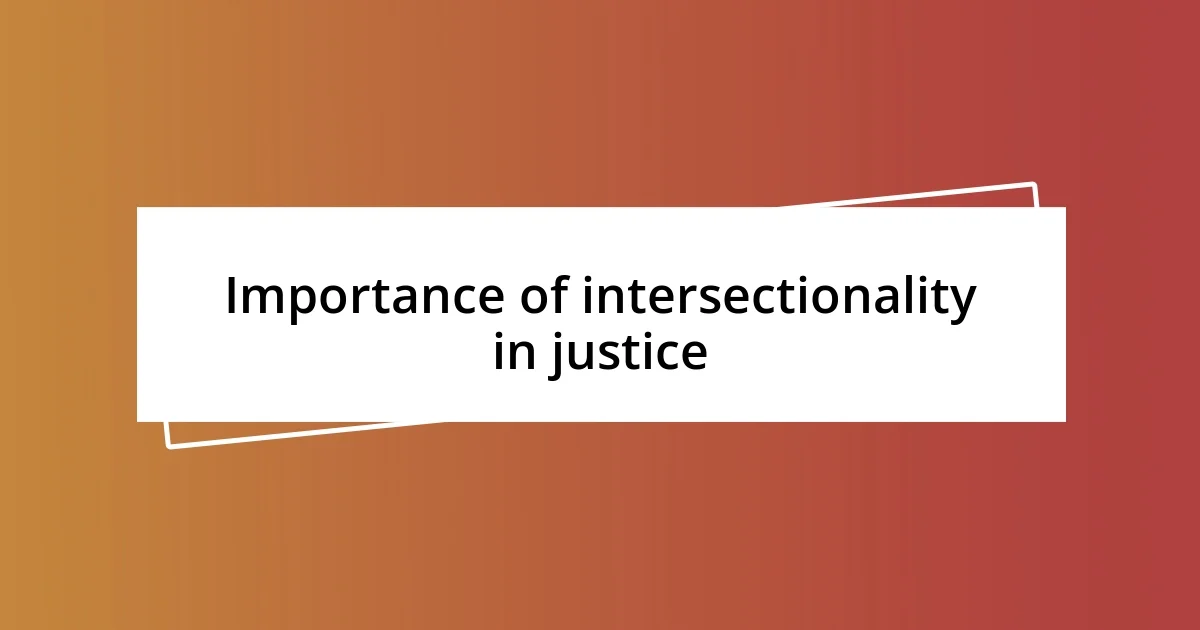
Importance of intersectionality in justice
Intersectionality is the cornerstone of understanding reproductive justice. It reminds me of a conversation I had with a friend who identified as a queer woman of color. She shared her challenges in accessing reproductive healthcare, highlighting how her identity shaped her experiences in ways I hadn’t fully grasped before. How can we engage in meaningful advocacy without acknowledging the diverse identities and obstacles that so many face? This intersectional lens is vital for creating solutions that resonate with everyone.
During my work in community outreach, I witnessed firsthand how different socio-economic statuses intersect with reproductive decisions. I met a young mother who juggled multiple jobs while trying to secure birth control access. Her struggle resonated deeply with me; it made me realize that reproductive justice isn’t just a matter of choice—it’s about equitable access to resources that can empower individuals. When we talk about justice, we cannot ignore the barriers that parenting, income level, and systemic discrimination create in the lives of people making these choices.
Through this understanding of intersectionality, I’ve come to appreciate the complexity of justice itself. It’s about more than just reproductive rights; it’s about dismantling systemic inequalities that prevent people from having true agency over their lives. I often reflect on moments in workshops where diverse voices came together, sharing the burdens of race, class, and gender identity. Each story illustrated that the fight for reproductive justice is inherently linked to broader fights for social equity. It’s a sobering reminder that our paths toward justice are deeply intertwined.
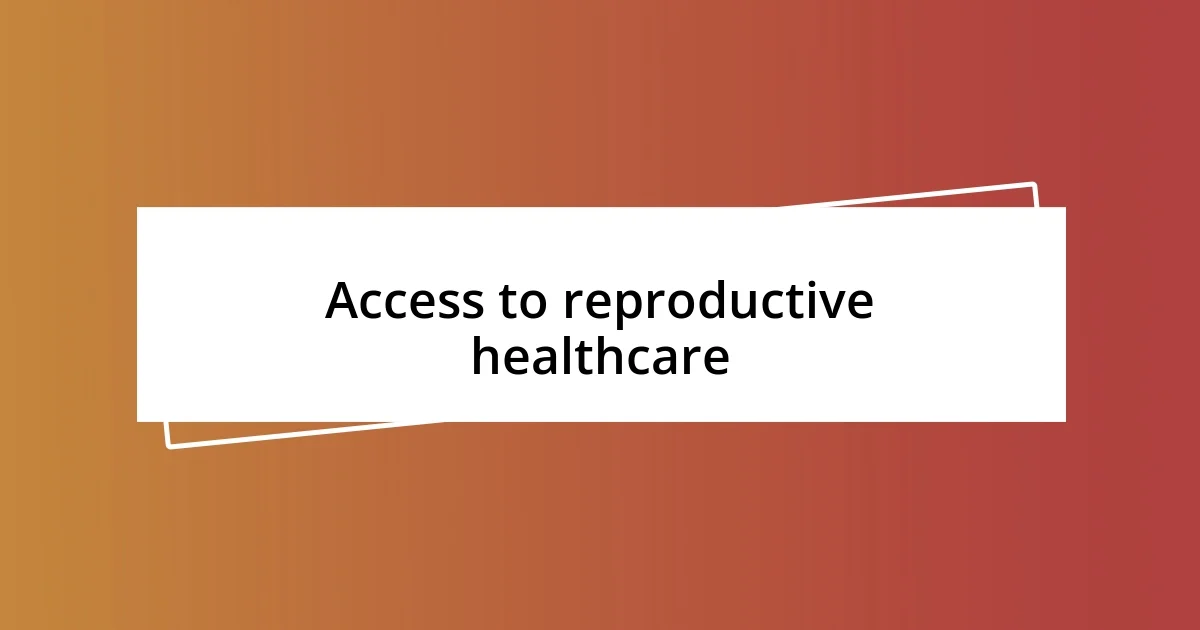
Access to reproductive healthcare
Access to reproductive healthcare is a fundamental aspect of reproductive justice that I’ve become increasingly passionate about. I remember a day when I volunteered at a clinic providing services to low-income individuals. Hearing clients share their stories made me acutely aware of the barriers they faced, from transportation issues to unaffordable costs. It had me questioning, how can we truly support reproductive choice when access remains such a challenge for so many?
Reflecting on those experiences, I realized that access is not just about physical availability; it’s also about the quality of care. There was a young woman I spoke with who shared her frustration after being dismissed by healthcare providers due to her financial situation. This made me wonder, how many others have felt the same way? Everyone deserves to be treated with respect and empathy while seeking the care they need. Each of these interactions reinforced my belief that our healthcare system should be a safe haven, not a source of stress or shame.
Moreover, I’ve learned that the fight for access often intersects with other social issues. For instance, I recall engaging in discussions about how rural areas often lack comprehensive reproductive health services. I think about my own experiences accessing care when living in a remote community—it was daunting, to say the least. This connection emphasizes the need for structural changes that ensure every individual, regardless of where they live, has the right to equitable reproductive healthcare. Wouldn’t it be a stronger community if everyone could make informed choices about their reproductive health?
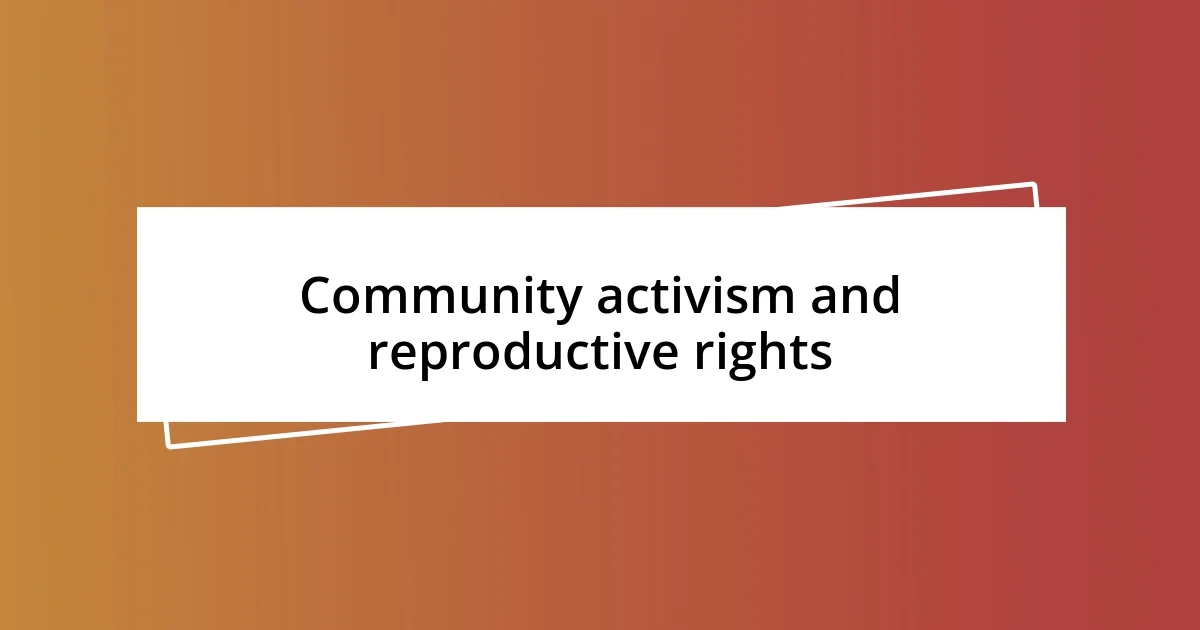
Community activism and reproductive rights
Community activism plays a pivotal role in advocating for reproductive rights, and I’ve witnessed this in my local community. I remember joining a grassroots organizing meeting where passionate voices united to address the lack of resources for expectant mothers in our area. It struck me how our collective effort could amplify individual struggles into a powerful call for change. Don’t you often feel that sense of energy when people come together with a shared purpose? It’s both invigorating and essential for pushing forward the dialogue around reproductive justice.
When I participated in a march advocating for comprehensive reproductive healthcare, it was more than just raising banners; it was about storytelling. As we walked, I heard stories of resilience from people who had been denied services or were forced to navigate an unwelcoming healthcare system. It made me realize that these personal experiences fuel our activism. Each narrative carried weight and purpose, reminding us that the fight for reproductive rights isn’t simply about policies—it’s about real lives and the values we uphold as a community.
In my advocacy work, I’ve also seen how collaboration among various organizations can strengthen our message. One memorable project involved teaming up with local nonprofits to create informational workshops on reproductive health. I loved watching community members transform as they gained knowledge and confidence about their rights. Isn’t it powerful to think that informed individuals can become advocates for themselves and others? This synergy not only enriches the community but also sparks a broader movement toward reproductive justice, emphasizing the need for unity in our efforts to effect change.
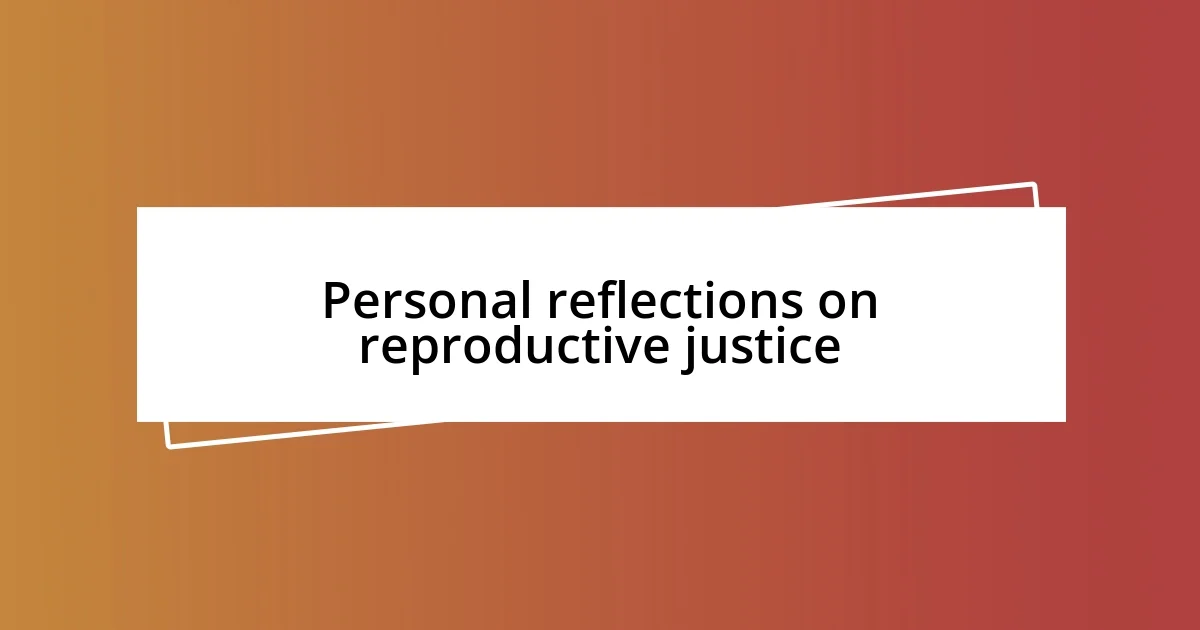
Personal reflections on reproductive justice
Reflecting personally on reproductive justice, I recall a moment during a workshop when someone shared her story about facing an unplanned pregnancy. I felt a mixture of empathy and anger as she recounted the isolation she experienced. It made me think, how many others have been in her shoes, feeling alone in such a critical situation? Hearing her motivates me to advocate for an environment where everyone can access support without fear of judgment.
I’ve also come to realize how discussions about reproductive justice often intersect deeply with my own identity. One day, while engaging in a community forum, I found myself reflecting on my privilege during those discussions. I’ve had relatively easy access to healthcare, but I couldn’t help but wonder, what about those who don’t have similar opportunities? Engaging with diverse perspectives is essential for me to understand the nuances of reproductive justice. It’s about more than just policies; it’s about recognizing the humanity in each of these stories.
Looking back, it truly strikes me how interconnected our experiences can be. I remember chatting with a friend who had faced significant barriers when trying to access contraception. She expressed feeling unheard in a system designed to support her. Listening to her, I couldn’t help but think how vital it is for us to stand together. In our interconnected lives, sharing these narratives can spark real change. Who’s to say that a single story can’t inspire a movement?







